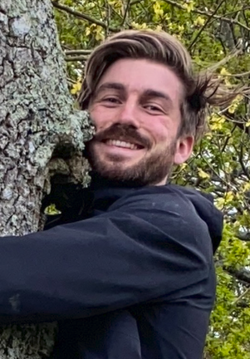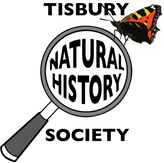 A reminder for our talk this coming Thursday when we welcome back Leif Bersweden. In 2021, Leif went on another big botanical adventure, this time travelling around Britain and Ireland with his bike, from Hampshire’s Bluebell woods to the shores of Shetland, to track down our most intriguing and well-known plants, with the people who love them most dearly. His talk is all about the joy of engaging with nature, the importance of plants for our climate, and celebrating our incredible botanical diversity. As he will explain, our resident flora is packed full of remarkable creatures. There are plants that poison predators, fight battles and play mind-games with pollinators. We have carnivores and climbers, puppeteers and parasites. Some are giants, thousands of years old, while others are tiny pinpricks a millimetre across. Leif Bersweden (writer, botanist and science communicator) grew up in rural Wiltshire where he taught himself to identify the local wildlife. More recently, he completed a genetics PhD at Kew Gardens and is the author of The Orchid Hunter (2017) and Where the Wildflowers Grow (2022). “Where the Wildflowers Grow: My Botanical Journey Through Britain and Ireland” with Leif Bersweden at the Victoria Hall, Tisbury at 7:30PM on Thursday 20th October will be live streamed on Zoom for any who want to hear the talk but are unable to come along in person. Our meetings are free to members and anyone under 21. Non-members are very welcome as visitors, on payment of a £2 cash contribution on the door. For Zoom links for guests or online payment details, please Contact us on the form. Members will receive their Zoom link by email. Did you know that the harvest mouse is the tiniest rodent in the UK and possibly the second cutest (scientific fact!) after the hazel dormouse? Did you know that there is a lot of uncertainty about the status of their populations but they are likely at some degree of endangered?
The Mammal Society is undertaking a National Harvest Mouse Survey to help address the enigma of their population status. The Wiltshire Mammal Group (WMG) will be supporting this project, leading survey and training events in Wiltshire this autumn; and we will be doing whatever we can to promote surveying in Tisbury and the local area. So if you haven't done a harvest mouse nest survey before, why don't you join one of the WMG free training events? The closest to us is on Sunday, November 20th, 10-12/12.30, at Pythouse (precise directions provided after booking). The leader will be our society member Peter G. Thompson, and you will need to email him (peter.gl.thompson at outlook.com) to book your place (numbers will be limited!) and for further details. If you cannot make this one, there are others further afield advertised in the WMG Facebook group. If you have done a harvest mouse nest survey before (perhaps you joined us on the one we organised in 2020?), why don't you take part by doing your own survey? If you would like to do your own survey but don't know where to do it, please get in touch. We are collaborating with the WMG in this and we will be able to let you know of under-recorded areas that will be interesting to survey. In September, we had the last field trip of the past season and the first talk of the new season.
The talk was on Rewilding archaeology, and was given by Ed Treasure, an environmental archaeologist at Wessex Archaeology. This was an interesting follow-up to our visit to Underhill Wood Nature Reserve, which some of us were lucky to be able to visit in April. Ed gave us a thought-provoking talk, starting with two definitions, one for environmental archaeology (the study of human and environmental interactions) and for rewilding (the reinstatement of natural processes, learning from the past), explaining how archaeology can be made relevant to approach current problems. Ed went on to explain why archaeological data, particularly palaeoenvironmental reconstruction, is relevant for the current interest in rewilding and acknowledged there are many ways of rewilding, in between two poles of "do nothing" and "do lots". Less than 1% of UK land is explicitly dedicated to rewilding, and most detailed baseline studies go back just 50 years. For example, what is officially referred to as ancient woods are areas of woodland that have persisted for just 400 years: 1600 in England and Wales, and 1750 in Scotland. This is hardly anything from the perspective of archaeology! Taking archaeological evidence into account, baselines can be brought back to several millennia ago, but the key question we need to ask ourselves as potential rewilders is, which specific moment of the past do we want to restore? One point of Ed's talk that may surprise our members is that archaeological evidence shows there is no true native woodland remaining in Britain. Although there are areas where woodland has been continuously present since the Early Holocene (the period after the last glaciation), the nature of this woodland has changed considerably. Ed also discussed the concept of wildwood or primeval forest, the woodland existing for a period after the last glaciation, from 12,000 years ago. The traditional view of this wildwood was of a closed canopy wood with some small clearances, until the first farming societies that started opening up the landscape. Ed referred to the first critique of this traditional view, Frans Vera's model, by which the primeval wood would have been in constant flux, with a mosaic of habitats "managed" by a range of large herbivores and beavers roaming in the landscape and creating openings. Vera's model is highly popular - it is one of the foundational ideas behind the rewilding project at Knepp, with which many of our members are familiar - and while the idea of the fluctuating woodland cover still holds true, the model has some problems that have arisen when contrasting some of its underlying hypotheses with the archaeological data. For example, it has become evident that large herbivores and beavers cannot be the only factors in creating openings in the landscape because most of these were absent from Ireland (unlike in Britain, where they were present) in the prehistoric past and environmental archaeological data tells us that Britain's and Ireland's landscapes were very similar. The role played by other factors, like carnivores, humans and fires for instance, are still under investigation. Another example given by Ed, this time closer to us, was the current development plan for the New Forest. Although this plan does not explicitly mentions "rewilding", it essentially proposes something of the sort, because it aims to make the NF more sustainable and reinstate the natural landscape of beech woodland and heathland. Ed highlighted that heathlands were created in the Bronze Age, a mere 4-3,000 years ago and that, although beech is native to the UK, beech woodlands only became common in the medieval period as a result of human management. So restoring those landscapes may be great to provide habitats for a range of wildlife, but are they truly "natural"? In summary, Ed didn't necessarily give us answers to many questions but I think this is one of the highlights of his talk. I am an environmental archaeologist too and I feel very uncomfortable when other archaeologists make big statements about the past that are largely interpretative and based on a series of disconnected facts; archaeological knowledge, like in many other disciplines, is not static and made of unsinkable truths. Ed rightly relativized the possible pathways for rewilding (it all depends on what specific time-landscape we want to restore) and he demonstrated the fluctuating nature of archaeological knowledge (and, therefore, of our understanding of the nature of the landscapes in the past). Rewilding can be a heated topic, but there isn't necessarily a right or wrong way of going about it, it just depends on giving careful thought to what we want to have for our baseline. You don't need to be a big landowner to be able to rewild anything, you can start with your small patch of concrete in the backyard or even with your windowsill. You can find out more about rewilding on the Rewilding Britain website. by Inés Lopez-Doriga Much has been said about the need to plant more trees to help to lock up carbon to help address climate change. So, it is particularly upsetting to see recently planted trees that have died during our dry summer and others weakened by the drought shedding their leaves early. This stress is in addition to the natural diseases with which they must contend as a matter of course.
Unfortunately, there are also diseases which, in our global economy, were imported from abroad accidentally. One such is the fungus that causes Ash Dieback. This was first identified in the UK in 2012 although there is evidence that it has been present in Europe for 30 years. It originates in Asia where it does little damage to the local ash species, but our ash - Fraxinus excelsior - has no natural defences to it. Ash is a common species and makes up around 12% of Britain’s broadleaved woodland so its loss will have a significant impact on the landscape. It is estimated that up to 80% of the trees will be killed, although as we are still the early stages of the epidemic, it is hard to judge. Whatever the losses, there will be an impact on those species of wildlife which rely upon ash. The disease can affect trees of all ages although young ones, and those growing in woodlands with high proportions of ash, seem to succumb most quickly. Trees growing in open locations such as streets or in hedgerows seem less susceptible and there appears to be a level of resistance in some trees which, although infected, survive. Local woodland managers have already been clearing ash trees and doubtless we will continue to see this in the years ahead. Those of us old enough to recall the dramatic change to the landscape caused by Dutch Elm Disease in the 1970’s will fear the long-term effect of Ash Dieback but will draw some comfort from the way that other species started to fill the gaps left when the elms were gone. But we must hope that further diseases do not erupt to thwart plans to increase our woodland cover as part of the essential work to lock up more carbon. by Andrew Graham |
Photo: Avocets (Izzy Fry)
The headers display photos taken by our members. Do get in touch via the Contact Form if you'd like to submit a photo for selection.
Archives
May 2024
Categories
All
|

 RSS Feed
RSS Feed